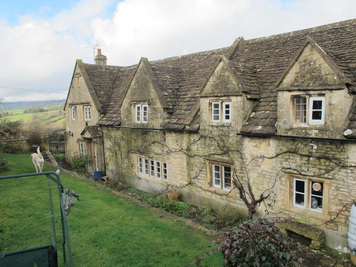
Mills Platt
Tracing the History of an Odd-shaped Plot
Alan Payne, March 2014
We were invited to visit and record the story of Mills Platt by current owners, Philip and Kate, who have kindly allowed us to publish the story of their marvellous house.
Tracing the History of an Odd-shaped Plot
Alan Payne, March 2014
We were invited to visit and record the story of Mills Platt by current owners, Philip and Kate, who have kindly allowed us to publish the story of their marvellous house.
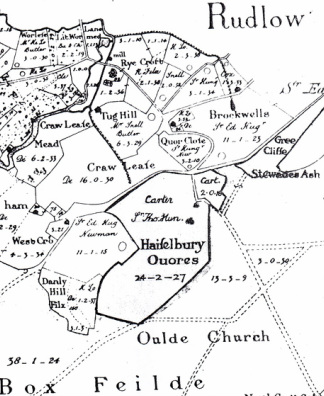 Mill Splatt shown above Quare Close in 1630
Mill Splatt shown above Quare Close in 1630
What is a Platt?
The word Platt, or more properly Splatt (meaning a small plot of land) has completely dropped out of our modern vocabulary. This is because in the Middle Ages it was a rare and notable event when farmland was divided up to create a small residential plot. Nowadays this has become commonplace with many infill houses.
It happened so rarely in the past that the name was used to identify two special locations in Box: Long Splatt and Mill Splatt.
Mill Splatt was created when a quarry near Drewetts Mill was carved out of a communal agricultural field which originally ran all the way down to the By Brook in an unbroken sweep of arable land.
The creation of the quarry left an irregular-shaped plot of land, not wanted by the quarry-owner but not big enough to provide a farming income on its own. Locals identified this as the Splatt of Land by Drewetts Mill (Mill Splatt).
The word Platt, or more properly Splatt (meaning a small plot of land) has completely dropped out of our modern vocabulary. This is because in the Middle Ages it was a rare and notable event when farmland was divided up to create a small residential plot. Nowadays this has become commonplace with many infill houses.
It happened so rarely in the past that the name was used to identify two special locations in Box: Long Splatt and Mill Splatt.
Mill Splatt was created when a quarry near Drewetts Mill was carved out of a communal agricultural field which originally ran all the way down to the By Brook in an unbroken sweep of arable land.
The creation of the quarry left an irregular-shaped plot of land, not wanted by the quarry-owner but not big enough to provide a farming income on its own. Locals identified this as the Splatt of Land by Drewetts Mill (Mill Splatt).
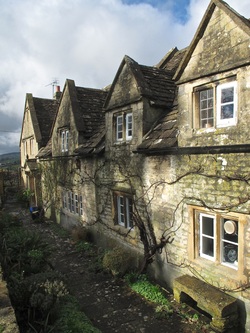 The row of cottages, now a single property
The row of cottages, now a single property
Farming Affluence
Usually small farms were inadequate for the tenant to support a large family and unpopular with landlords because they yielded low rents. We can suppose that the tenant at Mill Splatt Farm had a small domestic garden where he had an orchard and kept pigs, fowl and domestic animals. He probably leased strips of land in the nearby common fields. But this was subsistence survival only. The Mill Splatt area appears to be much more affluent than that.
We can see that the location was well placed for farming. It was near the fertile arable slopes of Box Fields, which straddle the current A4 road, and conveniently located for the large weekly market at Corsham.
More importantly, it was close to the By Brook river, where it could take advantage of the early hay meadows which ran along the river's banks. With enough hay it was possible to keep more animals over winter and to build up wealth with a large stock of animals.
New attitudes of individualism in Tudor society allowed some tenant farmers to exploit the economic opportunities which arose from a rapidly rising population. But to service the demand for food, farmers needed manpower at hand rather than relying upon the old communal labour of medieval times. So Mill Splatt Cottages were built as farm labourers residences close to the farmhouse.
We should see the cottages as reflecting the affluence of a thriving area. They were home for a number of families, a small terrace of farm labourers' properties in an isolated area, perhaps housing 10 adults; sometimes they were divided into four residences, sometimes further sub-divided. The oldest parts of the terrace are to be found in the kitchen and snug areas of the east cottage. Three cottages have the original chimney breast still evident; the oldest of these appears to have had two ground floor rooms with wooden ladder access into the roof space. Some had flagstone floors; some had a cellar beneath.
Usually small farms were inadequate for the tenant to support a large family and unpopular with landlords because they yielded low rents. We can suppose that the tenant at Mill Splatt Farm had a small domestic garden where he had an orchard and kept pigs, fowl and domestic animals. He probably leased strips of land in the nearby common fields. But this was subsistence survival only. The Mill Splatt area appears to be much more affluent than that.
We can see that the location was well placed for farming. It was near the fertile arable slopes of Box Fields, which straddle the current A4 road, and conveniently located for the large weekly market at Corsham.
More importantly, it was close to the By Brook river, where it could take advantage of the early hay meadows which ran along the river's banks. With enough hay it was possible to keep more animals over winter and to build up wealth with a large stock of animals.
New attitudes of individualism in Tudor society allowed some tenant farmers to exploit the economic opportunities which arose from a rapidly rising population. But to service the demand for food, farmers needed manpower at hand rather than relying upon the old communal labour of medieval times. So Mill Splatt Cottages were built as farm labourers residences close to the farmhouse.
We should see the cottages as reflecting the affluence of a thriving area. They were home for a number of families, a small terrace of farm labourers' properties in an isolated area, perhaps housing 10 adults; sometimes they were divided into four residences, sometimes further sub-divided. The oldest parts of the terrace are to be found in the kitchen and snug areas of the east cottage. Three cottages have the original chimney breast still evident; the oldest of these appears to have had two ground floor rooms with wooden ladder access into the roof space. Some had flagstone floors; some had a cellar beneath.
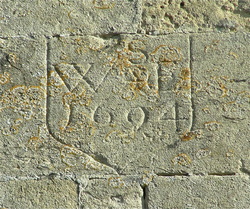
We can see the affluence of the area from the redevelopment of the west end of the row of cottages in 1694. The quality of the rebuilding reflects the wealth of a tenant who could afford the rent needed by the landlord to pay for the building work.
We don't know who did the building work of that time. A datestone was installed inscribed with the initials WS and P in the outside wall but no satisfactory combination of these initials has been found.[1] There has been speculation that the initials relate to the Speke family (W Speke-Petty). However, the precise ownership of the area and who did the rebuilding is unclear.
The owners of the area seem to have changed frequently at this time. The Long family probably owned the area from about 1450 but we don't have substantive proof until 1630 when a map of the area states that the plot was held by H Lo (Henry Long of Ashley). The property moved away from the influence of the Longs and there may have been a brief interlude of Speke involvement until eventually it came under the control of the Duckett family at Hartham estate to the east of Box village.
We don't know who did the building work of that time. A datestone was installed inscribed with the initials WS and P in the outside wall but no satisfactory combination of these initials has been found.[1] There has been speculation that the initials relate to the Speke family (W Speke-Petty). However, the precise ownership of the area and who did the rebuilding is unclear.
The owners of the area seem to have changed frequently at this time. The Long family probably owned the area from about 1450 but we don't have substantive proof until 1630 when a map of the area states that the plot was held by H Lo (Henry Long of Ashley). The property moved away from the influence of the Longs and there may have been a brief interlude of Speke involvement until eventually it came under the control of the Duckett family at Hartham estate to the east of Box village.
The Duckett Family
The Duckett family at Hartham (close to Mill Splatt) were possibly the people who rebuilt the property in 1694. Since the time of John Duckett (1580-1648), MP for Calne, the family had been known as of Hartham and Calstone and both placenames recur in the story.[2b] John's son William Duckett, gentleman, of Hartham House had acquired the Hatt part of the Speke estate in 1682, possibly including Drewetts Mill and Mill Splatt.[2] William was succeeded by his son, Lionel, who died December 1693 leaving his widow Martha Ash of Langley Burrell and three infant sons, George, William, and Henry-Stephens.[1b] The rebuilding of the cottages was possibly to provide an income for the family.
As we shall see, the connection between the parishes of Box and Calstone (sometimes called Calstone Wellington or Calne Without) continued for over a century. We see the association about 1708 when, the prolific vicar of Box, Rev George Millard, founded two charity schools: one at Box and another smaller one at my own Expence at Calstone.[3] Rev Millard followed up this initial work by substantial rebuilding works in Box: Box Church in 1713 and the founding of Box Poorhouse (now called Springfield House) in 1727.
Whilst we can't be certain that the Ducketts rebuilt Mill Splatt we can see that its restoration fits into the general mood of improvement of the time, which we call the Age of Enlightenment.
The Duckett family at Hartham (close to Mill Splatt) were possibly the people who rebuilt the property in 1694. Since the time of John Duckett (1580-1648), MP for Calne, the family had been known as of Hartham and Calstone and both placenames recur in the story.[2b] John's son William Duckett, gentleman, of Hartham House had acquired the Hatt part of the Speke estate in 1682, possibly including Drewetts Mill and Mill Splatt.[2] William was succeeded by his son, Lionel, who died December 1693 leaving his widow Martha Ash of Langley Burrell and three infant sons, George, William, and Henry-Stephens.[1b] The rebuilding of the cottages was possibly to provide an income for the family.
As we shall see, the connection between the parishes of Box and Calstone (sometimes called Calstone Wellington or Calne Without) continued for over a century. We see the association about 1708 when, the prolific vicar of Box, Rev George Millard, founded two charity schools: one at Box and another smaller one at my own Expence at Calstone.[3] Rev Millard followed up this initial work by substantial rebuilding works in Box: Box Church in 1713 and the founding of Box Poorhouse (now called Springfield House) in 1727.
Whilst we can't be certain that the Ducketts rebuilt Mill Splatt we can see that its restoration fits into the general mood of improvement of the time, which we call the Age of Enlightenment.
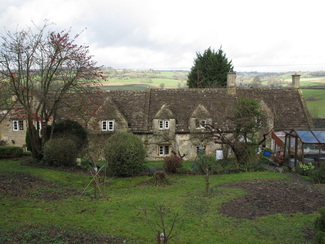
The London Road, 1761
Often an area like Mill Splatt would have developed into a thriving hamlet. It had the advantage of being worked by a successful tenant farmer and had a landlord who was prepared to invest in the area. But instead of continuing to expand, the development of the area stalled suddenly and in a most surprising way.
Its progress was altered in the 1700s by local road building. In 1761 a new road (now called the A4) was finally completed joining up Box and Corsham directly for the first time and it changed everything.
Before then traffic from London had to find a way into the village from the old medieval ridgeway road going through Kingsdown (the Old Bath Road). The old road from Wadswick down to Drewetts Mill had been one of the main routes for commercial vehicles to access the village from the Old Bath Road.
After 1761 Mills Platt was no longer on a major north-south arterial road down to the village; now most traffic accessed the village from the east through Corsham. The speed of carriages and horses going down the London Road meant that few people turned off the main road for the farm. The mail coach led the charge past the Mills Platt area as it sped into the centre of the village. Mills Platt was effectively by-passed by the new road, close to it but marginalised by it. The approach road to the farm deteriorated, traffic using it was restricted, and the terracing of the new road exacerbated the steepness of the slope down to the farm properties.
Worse still, a turnpike tollhouse and gates were built on the new road at the entrance to the village. It charged a toll for animals and traffic entering Box in order to pay for the road. The cost of this deterred the farmer at Mill Splatt from herding animals or taking a cart into central Box using the new road. It encouraged trade with Corsham or forced Mill Splatt to use the By Brook pathways. Thereafter Mill Splatt was on the outskirts of the village.
Often an area like Mill Splatt would have developed into a thriving hamlet. It had the advantage of being worked by a successful tenant farmer and had a landlord who was prepared to invest in the area. But instead of continuing to expand, the development of the area stalled suddenly and in a most surprising way.
Its progress was altered in the 1700s by local road building. In 1761 a new road (now called the A4) was finally completed joining up Box and Corsham directly for the first time and it changed everything.
Before then traffic from London had to find a way into the village from the old medieval ridgeway road going through Kingsdown (the Old Bath Road). The old road from Wadswick down to Drewetts Mill had been one of the main routes for commercial vehicles to access the village from the Old Bath Road.
After 1761 Mills Platt was no longer on a major north-south arterial road down to the village; now most traffic accessed the village from the east through Corsham. The speed of carriages and horses going down the London Road meant that few people turned off the main road for the farm. The mail coach led the charge past the Mills Platt area as it sped into the centre of the village. Mills Platt was effectively by-passed by the new road, close to it but marginalised by it. The approach road to the farm deteriorated, traffic using it was restricted, and the terracing of the new road exacerbated the steepness of the slope down to the farm properties.
Worse still, a turnpike tollhouse and gates were built on the new road at the entrance to the village. It charged a toll for animals and traffic entering Box in order to pay for the road. The cost of this deterred the farmer at Mill Splatt from herding animals or taking a cart into central Box using the new road. It encouraged trade with Corsham or forced Mill Splatt to use the By Brook pathways. Thereafter Mill Splatt was on the outskirts of the village.
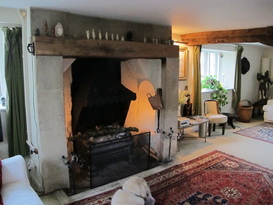
Owners and Occupiers
In 1797 the Rev T Heath of Calstone was the owner of Mill Splatt and let out the property to William Wiltshire, a yeoman farmer of Corsham, who was registered in 1818 as: occupier - himself and others at Millsplatt.
It is probable that William occupied the farmhouse and let the cottages to others, including his workers. Farming in the area was in decline and more cottages were let to people not associated with the farm.
In 1816 we find the name of a tenant carved into the fireplace in one of the cottages: John May a sieve and basket maker. With modern enamel and plastic pots, we forget the importance of rushes and willow baskets to provide cheap fishing and culinary utensils. We might imagine that John May harvested his materials from the By Brook area and sold the finished product locally in Box or Corsham. He probably only occupied one of the four cottages.
The cottages were often occupied by labourers. In 1841 all the properties, including the farmhouse, were tenanted by labourers and their families: James Hancock, John Dancy, William Iddols, John Shill, John Neate and James Alderman. Although small, some of the cottages themselves were further sub-divided into a room or two.
Modern Mills Platt
The connection between Box and Hartham House continued for centuries including the association with the Dickson-Poynder family who built the water Fountain in the centre of the village. But the area of Mill Splatt continued to decline.
The 1911 census records three residents in the area. In one John Clifford was a Crane Engine Fitter who lived with his wife, Anne, two grown-up sons who were labourers for the quarry, and a younger son. They occupied three rooms. Alfonso Gay a 74 year-old widower lived in a large cottage of 4 rooms, possibly in poverty. He is described as working as a Road Labourer repairing the highway. In the third house lived John Freebury, Free Stone Quarryman Chopper, who lived with his wife, Jane, in a kitchen and two bedrooms together with their three daughters and one son all under 10 years. There is no mention that the farmhouse was occupied. We might imagine that the residences had declined because the landlord's rental income was limited by a lack of takers.
The cottages were restored in recent years and joined together as a single residence. It is likely that Mill Splatt Farm concentrated on livestock husbandry. A pig sty existed at the cottages and until recently a butcher's shop was sited between the cottages and the A4 road.
We know that Drewetts Mill continued in use until the 1960s but corn grinding at the mill had been superseded in importance by the steam Flour Mill in the Market Place, Box. It is sometimes suggested that Drewetts became a paper mill but the history of the mill says that it was used for corn.
In 1797 the Rev T Heath of Calstone was the owner of Mill Splatt and let out the property to William Wiltshire, a yeoman farmer of Corsham, who was registered in 1818 as: occupier - himself and others at Millsplatt.
It is probable that William occupied the farmhouse and let the cottages to others, including his workers. Farming in the area was in decline and more cottages were let to people not associated with the farm.
In 1816 we find the name of a tenant carved into the fireplace in one of the cottages: John May a sieve and basket maker. With modern enamel and plastic pots, we forget the importance of rushes and willow baskets to provide cheap fishing and culinary utensils. We might imagine that John May harvested his materials from the By Brook area and sold the finished product locally in Box or Corsham. He probably only occupied one of the four cottages.
The cottages were often occupied by labourers. In 1841 all the properties, including the farmhouse, were tenanted by labourers and their families: James Hancock, John Dancy, William Iddols, John Shill, John Neate and James Alderman. Although small, some of the cottages themselves were further sub-divided into a room or two.
Modern Mills Platt
The connection between Box and Hartham House continued for centuries including the association with the Dickson-Poynder family who built the water Fountain in the centre of the village. But the area of Mill Splatt continued to decline.
The 1911 census records three residents in the area. In one John Clifford was a Crane Engine Fitter who lived with his wife, Anne, two grown-up sons who were labourers for the quarry, and a younger son. They occupied three rooms. Alfonso Gay a 74 year-old widower lived in a large cottage of 4 rooms, possibly in poverty. He is described as working as a Road Labourer repairing the highway. In the third house lived John Freebury, Free Stone Quarryman Chopper, who lived with his wife, Jane, in a kitchen and two bedrooms together with their three daughters and one son all under 10 years. There is no mention that the farmhouse was occupied. We might imagine that the residences had declined because the landlord's rental income was limited by a lack of takers.
The cottages were restored in recent years and joined together as a single residence. It is likely that Mill Splatt Farm concentrated on livestock husbandry. A pig sty existed at the cottages and until recently a butcher's shop was sited between the cottages and the A4 road.
We know that Drewetts Mill continued in use until the 1960s but corn grinding at the mill had been superseded in importance by the steam Flour Mill in the Market Place, Box. It is sometimes suggested that Drewetts became a paper mill but the history of the mill says that it was used for corn.
References
[1] Many of the details here are indebted to PM Slocombe Wiltshire Building Record, Wiltshire History Centre, 1992
[2] Duckett Family History, Wiltshire History Centre
[3] Wilts Archaeological & Natural History Society, Vol XXXI, p.36
[1b] www.ashefamily.info/ashefamily/2423.htm
[2b] www.historyofparliamentonline.org/volume/1604-1629/member/duckett-john-1580-1648
[1] Many of the details here are indebted to PM Slocombe Wiltshire Building Record, Wiltshire History Centre, 1992
[2] Duckett Family History, Wiltshire History Centre
[3] Wilts Archaeological & Natural History Society, Vol XXXI, p.36
[1b] www.ashefamily.info/ashefamily/2423.htm
[2b] www.historyofparliamentonline.org/volume/1604-1629/member/duckett-john-1580-1648
Residents of Mills Platt Cottages
|
Property
1911 Census Mills Platt Cottages (9 Rooms) 1901 Census Just Mills Platt no mention of Mills Platt Cottages - 4 Rooms 4 Rooms 3 Rooms 1 Room? 3 Rooms 1891 Census Mills Platt no mention of Mills Platt Cottages 3 rooms 2 rooms 3 Rooms 3 Rooms 3 Rooms 3 Rooms 1881 Census Mills Platt (no mention of Cottages) 1871 Census Mills Platt (no mention of cottages 1861 Census Mills Platt |
Residents
John Prior Ida Prior Ida Prior Albert Prior Irene Prior Edith Dickens Henry Allen Elizabeth James Cheeseman Ellen Cheeseman Ann Hillier John Clifford Anne Clifford George Ethel Ernest Elizabeth Edith Reggie Lily Alphonso Gay Fanny Gay Elsie Hilda Stanley Alphonso Gay Jane Frederick Gay Fanny Gay Frederick Gay Sarah Gay Albert Gay Ernest Gay Ann Wilkins John Clifford Annie Clifford George Clifford Eveline Clifford? Ernest Clifford Elizabeth Clifford Ann Hillier Henry Allen Elizabeth Allen James Coombes Alphonse Gay Jane Gay Frederick George Will Moore Sarah Moore Isaac Rebecca William Frances Hayward Herbert Hayward Henry Hillier Ann Hillier Ann Wilkins Emma Charles Hancock Rebecca Isaac Moore Joseph Gingell Mary Eliza Maryann Walter Ann Gray William Gray Elizabeth Alphonso Gay Jane Gay Frederick George Eleanor Hancock ? Gay Mary Webb Gay Francis George Margaret James Wilkins Ann Amelia Maryann Emma Mary Shele William Butler Lot Gray Ann Gray William Kezia Matthews Charlotte Harry Clara William Eatwell Emma Elizabeth |
Age
32 29 27 23 1 32 55 55 12 9 74 45 44 20 15 13 10 8 6 1 64 37 7 5 1 54 54 28 25 6 4 3 5 mnts 64 35 34 10 5 3 11mnts 64 45 44 46 44 44 18 12 31 27 7 3 9 mnts 40 8 61 53 54 12 34 37 75 29 30 8 5 2 44 25 23 34 34 8 2 59 29 27 1 69 42 44 13 10 3 78 77 35 34 15 32 37 7 4 48 48 10 |
Status
Head Wife Sister Brother Daughter Sister Head Wife Nephew Niece Widow Head Wife Son Daughter Son Daughter Daughter Son Daughter Head Daughter Daughter Son Head Wife Head Wife Son Daughter Son Son Head Wife Son Daughter Son Daughter Widow Head Wife Lodger Head Wife Son Son Head Wife Son Daughter Son Lodger Son Head Wife Head Daughter Head Wife Boarder Head Wife Daughter Daughter Son Head Son Daughter-in-law Head Wife Son Son Lodger Head Wife Son Mother Head Wife Daughter Daughter Daughter Head Brother Head Wife Son Head Wife Son Daughter Head Wife Daughter |
Notes
(John and Ida were living at Lower Rudloe Farm in 1901 Census) |